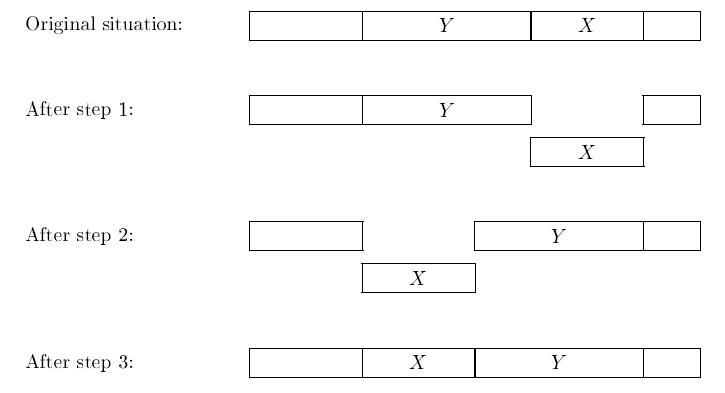hdu 1685 Booksort (IDA*)
Booksort
There is one department in the library, full of bookcases, where still the old way of borrowing is in use. Students can simply walk around there, pick out the books they like and, after registration, take them home for at most three weeks.
Quite often, however, it happens that a student takes a book from the shelf, takes a closer look at it, decides that he does not want to read it, and puts it back. Unfortunately, not all students are very careful with this last step. Although each book has a unique identification code, by which the books are sorted in the bookcase, some students put back the books they have considered at the wrong place. They do put it back onto the right shelf. However, not at the right position on the shelf.
Other students use the unique identification code (which they can find in an online catalogue) to find the books they want to borrow. For them, it is important that the books are really sorted on this code. Also for the librarian, it is important that the books are sorted. It makes it much easier to check if perhaps some books are stolen: not borrowed, but yet missing.
Therefore, every week, the librarian makes a round through the department and sorts the books on every shelf. Sorting one shelf is doable, but still quite some work. The librarian has considered several algorithms for it, and decided that the easiest way for him to sort the books on a shelf, is by sorting by transpositions: as long as the books are not sorted,
take out a block of books (a number of books standing next to each other),
shift another block of books from the left or the right of the resulting ‘hole’, into this hole,
and put back the first block of books into the hole left open by the second block.
One such sequence of steps is called a transposition.
The following picture may clarify the steps of the algorithm, where X denotes the first block of books, and Y denotes the second block.

Of course, the librarian wants to minimize the work he has to do. That is, for every bookshelf, he wants to minimize the number of transpositions he must carry out to sort the books. In particular, he wants to know if the books on the shelf can be sorted by at most 4 transpositions. Can you tell him?
One line with one integer n with 1 ≤ n ≤ 15: the number of books on a certain shelf.
One line with the n integers 1, 2, …, n in some order, separated by single spaces: the unique identification codes of the n books in their current order on the shelf.
if the minimal number of transpositions to sort the books on their unique identification codes (in increasing order) is T ≤ 4, then this minimal number T;
if at least 5 transpositions are needed to sort the books, then the message "5 or more".
6
1 3 4 6 2 5
5
5 4 3 2 1
10
6 8 5 3 4 7 2 9 1 10
3
5 or more
#include <iostream>
#include <cstdio>
#include <cstring>
#include <queue>
#define maxn 16
using namespace std; int n,m,ans,depth,flag;
int a[maxn]; bool isok()
{
int i,j;
for(i=1;i<=n;i++)
{
if(a[i]!=i) return false ;
}
return true ;
}
int h()
{
int i,j,t=0;
for(i=0;i<=n;i++)
{
if(a[i]+1!=a[i+1]) t++;
}
return t;
}
void dfs(int d)
{
if(isok())
{
flag=1;
return ;
}
if(flag||(d-1)*3+h()>depth*3) return ; // 实现IDA*
int i,j,k,p;
int tmp[maxn];
for(i=1; i<=n; i++) // 模拟操作
{
for(j=i; j<=n; j++)
{
for(k=1; k<=i-1; k++)
{
memcpy(tmp,a,sizeof(tmp));
for(p=k; p<=i-1; p++)
{
a[p+j-i+1]=tmp[p];
}
for(p=i; p<=j; p++)
{
a[p-i+k]=tmp[p];
}
dfs(d+1);
memcpy(a,tmp,sizeof(tmp));
}
for(k=j+1; k<=n; k++)
{
memcpy(tmp,a,sizeof(tmp));
for(p=j+1; p<=k; p++)
{
a[p-j-1+i]=tmp[p];
}
for(p=i; p<=j; p++)
{
a[p+k-j]=tmp[p];
}
dfs(d+1);
memcpy(a,tmp,sizeof(tmp));
}
}
}
}
int main()
{
int i,j,t,flg;
scanf("%d",&t);
while(t--)
{
scanf("%d",&n);
flg=1;
for(i=1; i<=n; i++)
{
scanf("%d",&a[i]);
if(a[i]!=i) flg=0;
}
a[0]=0,a[n+1]=n+1;
if(flg)
{
printf("0\n");
continue ;
}
flag=depth=0;
while(!flag)
{
depth++;
dfs(1);
if(depth>=4) break ;
}
if(flag) printf("%d\n",depth);
else printf("5 or more\n");
}
return 0;
}
hdu 1685 Booksort (IDA*)的更多相关文章
- POJ 1077 HDU 1043 Eight (IDA*)
题意就不用再说明了吧......如此经典 之前想用双向广搜.a*来写,但总觉得无力,现在用IDA*感觉其他的解法都弱爆了..............想法活跃,时间,空间消耗很小,给它跪了 启发式搜索关 ...
- DNA sequence HDU - 1560(IDA*,迭代加深搜索)
题目大意:有n个DNA序列,构造一个新的序列,使得这n个DNA序列都是它的子序列,然后输出最小长度. 题解:第一次接触IDA*算法,感觉~~好暴力!!思路:维护一个数组pos[i],表示第i个串该匹配 ...
- HDU 2485 Destroying the bus stations (IDA*+ BFS)
传送门:http://acm.hdu.edu.cn/showproblem.php?pid=2485 题意:给你n个点,m条相连的边,问你最少去掉几个点使从1到n最小路径>=k,其中不能去掉1, ...
- HDU 1813 Escape from Tetris (IDA*)
传送门:http://acm.hdu.edu.cn/showproblem.php?pid=1813 题意:给你一个n*n的迷宫,其中0代表有一个人在这个位置,1代表墙,现在要求一个路线,使所有的人通 ...
- POJ3460 Booksort(IDA*)
POJ3460 Booksort 题意:给定一个长度为n的序列,每次可以取出其中的一段数,插入任意一个位置,问最少需要几次操作才能使整个序列变为1~n 思路:IDA*+迭代加深搜索 小技巧:将一段数插 ...
- hdu 2234(IDA*)
题目链接:http://acm.hdu.edu.cn/showproblem.php?pid=2234 思路:IDA*可以搞,借鉴的是大牛的启发式函数h(): 可以考虑把每一行上的数转化成相同的,或者 ...
- hdu 1667(IDA*)
题目链接:http://acm.hdu.edu.cn/showproblem.php?pid=1667 思路:大牛说是IDA*的入门题=.=构造h()=8-max(1,2,3); max(1,2,3 ...
- HDU 1043 & POJ 1077 Eight(康托展开+BFS | IDA*)
Eight Time Limit: 1000MS Memory Limit: 65536K Total Submissions: 30176 Accepted: 13119 Special ...
- HDU 1560 DNA sequence (IDA* 迭代加深 搜索)
题目地址:http://acm.hdu.edu.cn/showproblem.php?pid=1560 BFS题解:http://www.cnblogs.com/crazyapple/p/321810 ...
随机推荐
- jquery 的缺点
接口不统一 其中.each();.map();$.each();这些方法的参数函数的参数顺序是index, value这种顺序.但是$.map();方法的参数函数的参数顺序则是value,index这 ...
- Android Marquee
android:singleLine="true" android:marqueeRepeatLimit="marquee_forever" android:e ...
- thinkphp对文件的上传,删除,下载操作
工作需要,整理一下最近对php的学习经验,希望能对自己有帮助或者能帮助那些需要帮助的人. thinkphp对文件的操作,相对来说比较简单,因为tp封装好了一个上传类Upload.class.php 废 ...
- C# 中使用 OpenSSL 的公钥/私钥进行加密和解密
在C#中进行RSA解密,需要用RSACryptoServiceProvider,但是不支持OpenSSL格式的公钥或者私钥. X509 公钥 -----BEGIN PUBLIC KEY----- MI ...
- 深入了解使用egret.WebSocket
概念 本教程不讲解TCP/IP协议,Socket属于哪层,消息包体怎么设计等,主讲 egret.WebSocket 使用示例 与 protobuf 使用示例. 在使用egret.WebSocket之前 ...
- __PUBLIC__模板文件路径配置
__PUBLIC__ 默认指向 项目文件下的Public文件夹 注意: __PUBLIC__不是一个常量,只在模板中进行替换,__ROOT__是一个常量 项目文件路径 defined('__PUBLI ...
- WinPcap编程(前言&&学习)
计算机网络课设要求用WinPcap写对ARP包的接收与发送. 所以学了一下WinPcap的内容. 参考的博客: http://blog.csdn.net/htttw/article/details/7 ...
- ORACLE数据库操作基本语句
1.登陆SPL*PLUS [username/password] [@server] as [sysdba|sysoper] eg. system/password or connect sys/pa ...
- Spark笔记--使用Maven编译Spark源码(windows)
1. 官网下载源码 source code,地址: http://spark.apache.org/downloads.html 2. 使用maven编译: 注意在编译之前,需要设置java堆大小以及 ...
- IPv6-only 的兼容性解决方案-b
前几天Apple宣布 6月1日后所有应用必须支持IPv6-only网络 今天抽空看了下这方面的知识 首先解释下IPv6的是什么? 维基百科的定义如下:IPv6是Internet Protocol ve ...
